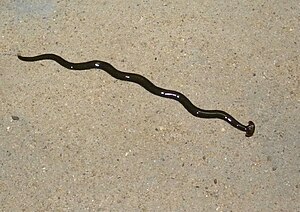Bipalium kewense
| Bipalium kewense | ||||||||||||
|---|---|---|---|---|---|---|---|---|---|---|---|---|

Bipalium kewense , head right (very dark specimen) |
||||||||||||
| Systematics | ||||||||||||
|
||||||||||||
| Scientific name | ||||||||||||
| Bipalium kewense | ||||||||||||
| Moseley , 1878 |
Kewense Bipalium or Hammerhaiwurm is to the country planarians counting (Geoplanidae) Strudelwurm extending from earthworms fed. Originally presumablynativeto Southeast Asia, it can now be found in large parts of North America , but also in Great Britain and France .
features
The flatworm becomes about 5 to 35 centimeters long and 3 to 5 millimeters wide. The head of the worm is crescent-shaped or "hammer head-like" widened while the tail end is pointed. The animal is yellow-brown with five dark purple vertical stripes. Three thinner, darker stripes run down the center and along the edges of the back, two more, thicker and lighter stripes between the other three. There are numerous pinpoint eyes on the head.
Toxicity
Recent research shows that the hammerhead worm produces one of the most powerful toxins known, tetrodotoxin . Tetrodotoxin is u. a. known from puffer fish. Since the species spreads in Central and Western Europe, an accumulation of the poison in the soil of the infested areas must be expected.
Life cycle
Bipalium kewense is, like all strudelworms, a hermaphrodite , but the species has only seldom been observed during sexual reproduction. Egg capsules are deposited from which young animals hatch after a few weeks. At least in Great Britain, reproduction usually takes place asexually, with the animal shedding its 2 to 4 cm long section, which then grows a new head.
Habitat and Distribution

It is believed that Bipalium kewense is native to Southeast Asia . In the UK, the flatworm is mostly found in greenhouses. Henry Nottidge Moseley first described the species in 1878 in the Royal Botanic Gardens (Kew) in London . Bipalium kewense has also been found in Germany since 1898 in various greenhouses, including the botanical and zoological gardens of Breslau, Berlin, Hamburg, Dresden, Leipzig and Bonn, but not outdoors. In May 2018, a work was also published on numerous sightings of the species in France, where the species has probably been common for several years.
food
Bipalium kewense eats earthworms . It wraps around its prey, everts its trunk-like throat ( pharynx ) and digests it with the help of digestive enzymes before it is sucked in through the mouth opening on the abdomen by pumping movements of the pharynx.
Synonyms
Moseley described the species under the name Bipalium kewense , which is valid today , but the synonyms Placocephalus kewensis and Sphyrocephalus kewense have also been used since then .
literature
- Hugh D. Jones: British land flatworms . British Wildlife, February 2005. pp. 189-194. Bipalium kewense: p. 194. PDF
- Walther Arndt (1934): The land planar finds in Germany. With an overview of the terricoles currently known from Europe . Zoogeographica, pp. 375-392. Placocephalus kewensis (Mos.) , Pp. 383f. PDF
Web links
Individual evidence
- ↑ Amber N. Stokes et al .: Confirmation and Distribution of Tetrodotoxin for the First Time in Terrestrial Invertebrates: Two Terrestrial Flatworm Species (Bipalium adventitium and Bipalium kewense). PLoS ONE 9 (6): e100718, 2014, doi: 10.1371 / journal.pone.0100718 .
- ↑ Lars Fischer: Invasion of Hammerhead Worms . Spektrum.de. May 23, 2018. Retrieved November 19, 2019.
- ^ PK Ducey, J. Cerqua, LJ West, M. Warner (2006): Rare egg capsule production in the invasive terrestrial planarian Bipalium kewense . Southwest Naturalist 51 (2), pp. 252-254.
- ^ Leigh Winsor (1983): A revision of the cosmopolitan land planarian Bipalium kewense Moseley, 1878 (Turbellaria: Tricladida: Terricola) . Zoological Journal of the Linnean Society 79, pp. 61-100.
- ↑ Walther Arndt (1934), p. 383f.
- ↑ Jean-Lou Justine, Leigh Winsor, Delphine Gey, Pierre Gros, Jessica Thévenot: Giant worms chez moi! Hammerhead flatworms (Platyhelminthes, Geoplanidae, Bipalium spp., Diversibipalium spp.) In metropolitan France and overseas French territories. PeerJ, May 22, 2018. doi : 10.7717 / peerj.4672
